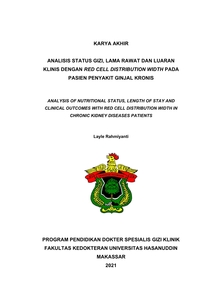Rahmiyanti, Layle (2021) Analisis status gizi, lama rawat, dan luaran klinis dengan red cell distribution width pada pasien penyakit ginjal kronis = Analysis of nutritional status, length of stay and clinical outcomes with red cell distribution width in chronic kidney diseases patients. Thesis thesis, Universitas Hasanuddin.
![[thumbnail of Cover]](/22831/1.hassmallThumbnailVersion/C117216201_tesis_cover1.jpg)

C117216201_tesis_cover1.jpg
Download (312kB) | Preview
C117216201_tesis_bab 1-2.pdf
Download (534kB)
C117216201_tesis_dp.pdf
Download (277kB)
C117216201_tesis.pdf
Restricted to Repository staff only until 1 November 2024.
Download (1MB)
Abstract (Abstrak)
Introduction: Red cell distribution width (RDW) shows the heterogeneity of erythrocyte size associated with inflammation and various clinical conditions including in patients with chronic kidney disease (CKD). Systemic inflammation and oxidative stress were commonly found in CKD patients. This study aimed to examine the relationship of nutritional status, length of hospital stay (LOS), and clinical outcome to RDW in CKD patients.
Methods: We conducted a retrospective cohort study of 1736 patients CKD patients who admitted from January 2017 to August 2020, aged between 18-60 years, and were hospitalized at Wahidin General Hospital. From those, 239 were consulted with a Clinical Nutrition specialist, of which 59 patients eligible with the criteria inclusion. Data were collected through medical records and through electronic data (biochemical data). RDW was categorized into normal and high RDW group, Nutritional status based on subjective global assessment (SGA), LOS less than 10 days and clinical outcome based on conditions at the time of hospital discharged. Data were analysed using SPSS version 25.0.
Results: The data of 59 patients were analyzed, the mean age was 50.42 years (normal RDW) and 47.24 years (high RDW), most of them are women (57.7% vs 60.6%). There were 42 patients with moderate malnutrition (23 normal RDW and 19 high RDW) and 17 patients with severe malnutrition (3 normal RDW and 14 with high RDW). The study found significant differences between normal RDW and high RDW (p 0.021), but not significant differences in LOS (p 0.890) and clinical outcome (p 0.968). There were significant differences in the levels of haemoglobin (p = 0.001), RBG (p = 0.030), and serum sodium level (p = 0.010). Patient with LOS <10 days had lower sodium levels and more severe anemia when compared with LOS >10 days and the poor clinical outcome had a heavier degree of anemia compared to the good clinical outcomes.
Conclusion: Poor nutritional status was associated with an increase in RDW, degree of anemia and sodium level.
Keywords : nutritional status, length of stay, clinical outcome, RDW
| Item Type: | Thesis (Thesis) |
|---|---|
| Uncontrolled Keywords: | nutritional status, length of stay, clinical outcome, RDW |
| Subjects: | R Medicine > R Medicine (General) |
| Divisions (Program Studi): | Fakultas Kedokteran > PPDS - Ilmu Gizi Klinik |
| Depositing User: | S.Sos Rasman - |
| Date Deposited: | 10 Nov 2022 06:09 |
| Last Modified: | 10 Nov 2022 06:09 |
| URI: | http://repository.unhas.ac.id:443/id/eprint/22831 |


